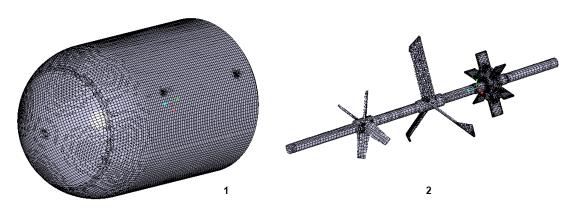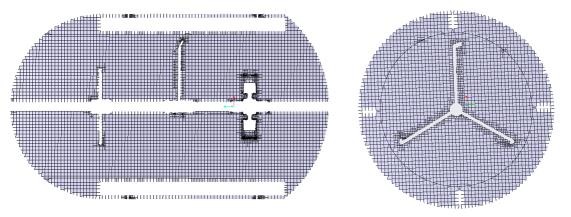Mixing Tank: Exercise 3—Preparing the Mesh
A mesh is a computational grid inside, outside, or both inside and outside any closed geometry defined by a CAD surface.
Generating the Mesh
• 1 = Stator
• 2 = Rotor
1. In the Flow Analysis Tree, select
 Domains
Domains.
2. In the Properties panel, Model tab, for Mesh Generation, type the following values:
◦ Maximum Cell Size — 0.01
◦ Minimum Cell Size — 0.001
◦ Cell Size on Surfaces — 0.01
The values are retained as default settings. You can change these if required.
3. Click
 Generate Mesh
Generate Mesh to create the mesh for the fluid domain.
4. Select
 Domains
Domains.
5. In the Properties panel, View tab, set Keep drawing, Grid, and Outline to Yes. The mesh for the boundary FLUID_ROTOR appears in the graphics window.
6. Under
 Boundary Conditions
Boundary Conditions >
 General Boundaries
General Boundaries >
Interface, right-click
FLUID_ROTOR/FLUID_STATOR and select
Separate and Connect.
Viewing the Mesh
• 1 = Section 01
• 2 = Section 02
1. Clear
 Flow Analysis Bodies
Flow Analysis Bodies.
2. In the
Post-processing group, click
 Section View
Section View. The
Section 01 Properties dialog box appears.
3. Set values for the options as listed below:
◦ Type — Plane Y
◦ Arbitrary Plane — 0
4. In the Properties panel, View tab, set Keep drawing, Grid, and Outline to Yes. The mesh for the section appears in the graphics window.
5. In the
Post-processing group, click
 Section View
Section View. The
Section 02 Properties dialog box appears.
6. Set values for the options as listed below:
◦ Type — Plane Z
◦ Arbitrary Plane — 0.575
7. Select Section 02.
8. In the Properties panel, View tab, set Keep drawing, Grid, and Outline to Yes. The mesh for the section appears in the graphics window.
9. Click
 Generate Mesh
Generate Mesh to create the mesh for the fluid domain.
10. Select
 Domains
Domains.
11. In the Properties panel, View tab, set Keep drawing, Grid, and Outline to Yes. The mesh for the boundary FLUID_ROTOR appears in the graphics window.
12. Under
 Boundary Conditions
Boundary Conditions >
 General Boundaries
General Boundaries >
Interface, right-click
FLUID_ROTOR/FLUID_STATOR and select
Separate and Connect.


 Domains.
Domains. Generate Mesh to create the mesh for the fluid domain.
Generate Mesh to create the mesh for the fluid domain. Domains.
Domains. Boundary Conditions >
Boundary Conditions >  General Boundaries > Interface, right-click FLUID_ROTOR/FLUID_STATOR and select Separate and Connect.
General Boundaries > Interface, right-click FLUID_ROTOR/FLUID_STATOR and select Separate and Connect.
 Flow Analysis Bodies.
Flow Analysis Bodies. Section View. The Section 01 Properties dialog box appears.
Section View. The Section 01 Properties dialog box appears. Section View. The Section 02 Properties dialog box appears.
Section View. The Section 02 Properties dialog box appears. Generate Mesh to create the mesh for the fluid domain.
Generate Mesh to create the mesh for the fluid domain. Domains.
Domains. Boundary Conditions >
Boundary Conditions >  General Boundaries > Interface, right-click FLUID_ROTOR/FLUID_STATOR and select Separate and Connect.
General Boundaries > Interface, right-click FLUID_ROTOR/FLUID_STATOR and select Separate and Connect.